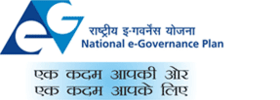National e-Governance Plan
| राष्ट्रीय ई-शासन योजना | |
 Public Services Closer Home | |
| Abbreviation | NeGP |
|---|---|
| Motto | Public Services Closer Home |
| Formation | May 18, 2006[1] |
| Headquarters | New Delhi |
| Location |
|
Region served | India |
President & CEO (NeGD) | Ms Radha Chauhan, IAS |
Parent organisation | Ministry of Electronics and Information Technology |
| Website |
meity |
The National e-Governance Plan (NeGP) is an initiative of the Government of India to make all government services available to the citizens of India via electronic media.[2] NeGP was formulated by the Department of Electronics and Information Technology (DeitY) and Department of Administrative Reforms and Public Grievances (DARPG). The Government approved the National e-Governance Plan, consisting of 27 "Mission Mode Projects" (MMPs) and Tencomponents, on 18 May 2006.[1] This is an enabler of Digital India initiative, and UMANG (Unified Mobile Application for New-age Governance) in turn is an enabler of NeGP.
The plan
Background
The 11th report of the Second Administrative Reforms Commission, titled "Promoting e-Governance - The Smart Way Forward", established the government's position that an expansion in e-Government was necessary in India.[2] The ARC report was submitted to the Government of India on 20 December 2008.[3] The report cited several prior initiatives as sources of inspiration, including references to the Singapore ONE programme. To pursue this goal, the National e-Governance Plan was formulated by the Department of Information Technology (DIT) and Department of Administrative Reforms & Public Grievances (DAR&PG). The program required the development of new applications to allow citizen access to government services through Common Service Centers; it aimed to both reduce government costs and improve access to services.[4]
Criticism
Lack of needs analysis, business process re-engineering, interoperability across MMPs, and coping with new technology trends (such as mobile interfaces, cloud computing, and digital signatures) were some of the limitations of the initiative.[5]
References
See also
Citations
- 1 2 NeGP website. "Approval Details of NeGP". NeGP Website. Archived from the original on 19 February 2013. Retrieved 17 July 2014.
- 1 2 "Second Administrative Reforms Commission Report". Arc.gov.in. Retrieved 2011-03-01.
- ↑ "Second Administrative Reforms Commission Preface to the Report" (PDF). Retrieved 2011-03-01.
- ↑ Indg. "about NeGP". Indg.in. Archived from the original on 19 April 2012. Retrieved 17 July 2014.
- ↑ Revisiting NeGP: eBharat2020:The proposed future NeGP 2.0 by CSR Prabhu in CSI Communications Oct 2011 (access date 5 Mar 2012)